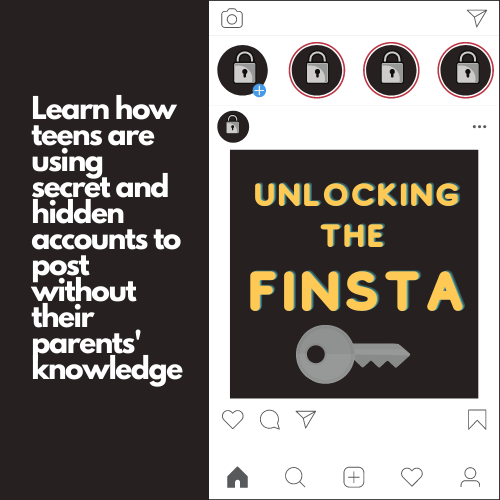It may seem like there couldn’t be more for a parent to be concerned about regarding their child’s social media use. However, the trendy phenomenon of the finsta (short for fake Instagram) should be on parents’ radars. Many teens feel pressured to keep up a certain image with what they post on their main Instagram account. Finstas allow teens to be more lax with what they post. However, these hidden social media accounts can become an issue if teens are misusing them.
Fake social media accounts present a host of problems, and not just for parents. Kids and teens who experience bullying, peer pressure and other issues may not want to get help from an adult in fear they might get in trouble for having a fake account to begin with.
Teaching responsible social media use and skills has never been more important! If you are having concerns about your child using a finsta or other hidden social media accounts, read on to learn more!
What is a finsta?
A finsta account is a secondary Instagram account where users post to a smaller audience of followers than their main account. Users set usernames to fake names and hide any forward-facing personal information. Teens only give out the username of their finsta to people that they approve of seeing what they are posting. This means your child could have a finsta and you may not even know it.
Teens use finstas to post photos and captions that are more personal than what they post on their main account. Common posts teens put up on their finsta include memes, selfies, long rants about events happening in their lives, and even embarrassing images of themselves or others.
Since only a few people are meant to see the posts, finsta users may feel more comfortable sharing private and personal information on their account. Posting on a finsta could be harmful if the teen does not recognize potential consequences for inappropriate finsta posts.
The finsta has become a digital diary for many teens. Users create finstas under a fake name or in a way that they feel a sense of anonymity, and most are private accounts. Teens allow only their closest circle to see the “exclusive” content on their finsta. The nature of finstas could easily lead teens to feel more lax before thinking what they are posting.
Other people are still able to screenshot posts and comments even if a finsta account is private. If a teen is posting age-inappropriate content, mean posts cyberbullying others, or worrisome posts about mental health struggles or suicidal thoughts, adult intervention is absolutely necessary.
Should parents be worried about their teens using finstas and other hidden social media accounts?
Parents need to ask their teens why they want to have a fake social media account to begin with.
Is it because their child wants to have a feeling of freedom to post things away from adult eyes? Is it because their child’s friends all have finstas and they don’t want to be the odd one out? What kind of posts are their child’s friends putting up on their finstas?
Parents, teachers, and employers are being intentionally excluded from seeing what teens are posting on their finstas. Teens might have a hard time understanding how the secrecy of finstas could impact what they post. If parents aren’t able to monitor their child’s online activity, their child could see or create inappropriate content.
If a parent feels that their child has a finsta or other hidden social media accounts, it is important that the parent asks them. An indicator for parents that a teen is using a finsta is if their teen’s friends are following an account that has a small number of followers. Another indicator is if the accounts’ username is an inside joke or clever play on the teen’s name. Users can be logged into more than one Instagram account at a time on a single device. Parents can ask their teens to look at their Instagram app. However, teens can easily log out of any finsta accounts before giving their phone to their parents.
Parents should be aware of all social media platforms and accounts that their children are using. This makes it easier for parents to monitor their children’s posts and online interactions. Teens could be posting harmful and inappropriate content on their hidden finsta. Parents need to be aware so they can help guide their child and teach them about being good digital citizens.





